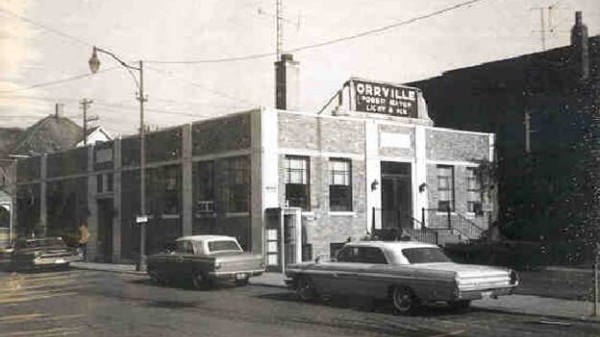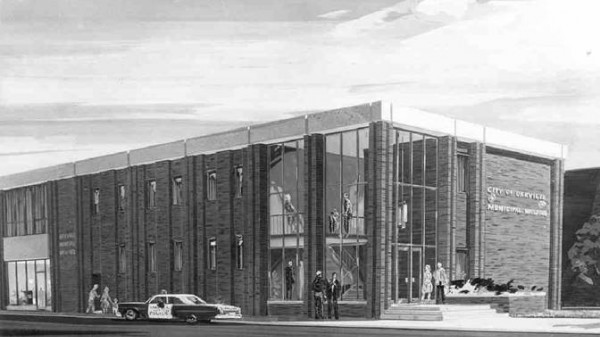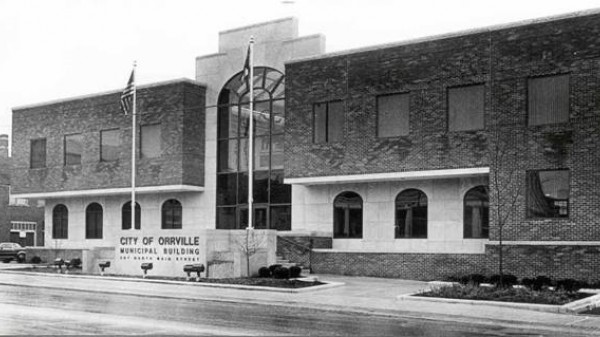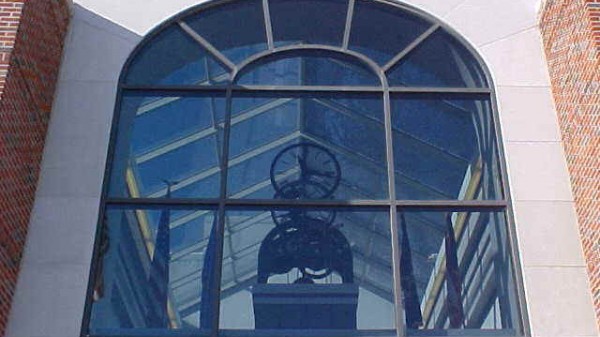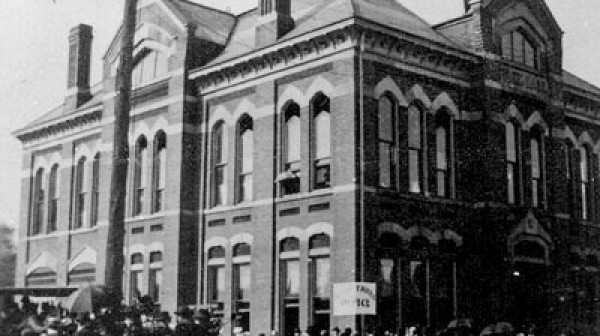Arrival of Settlers | Growth of Railroad | Surrounding Property | Early Businesses | Population | Government | Official Flag and Seal | Clock Tower | Schools | Present Day | Listing of Officials from 1865
Excerpt from History of Wayne County, Ohio from the days of the Pioneers and First Settlers. Published in 1878.
Every community is unique. No other small city in the world is quite like Orrville. Its difference comes from its particular blending of geography, history, and human personality.
ARRIVAL OF SETTLERS
Community history began in 1814 with the arrival of a veteran of the Revolutionary War, James Taggart Jr., to stake out the claim to which his war service entitled him. He chose a quarter section (160 acres) in Baughman Township, deep in the heart of what is now Orrville, lying east of Main Street, between Orr Street and the southern corporation line. He later returned to his home in Washington County, Pennsylvania, but the next year his sons, Samuel and Robert Taggart, came to settle on this claim. The Taggarts were of Irish extraction. Other early settlers, the Horst, Brenneman and Seas families, were of Pennsylvania Dutch and German heritage.
James Taggart's son, Samuel, built the first house in this section in 1828, and from that unpretentious beginning, Orrville grew. (This house is still standing today at 421 East Fike Street and is a private residence.) During the Civil War, this house was one of those in the chain of the Underground Railway which sent slaves to freedom in the North.
In 1851, the Pittsburgh and Fort Wayne Railroad was being promoted through this area and one day, soon after the news was heard by the settlers in the area, Smith Orr and Christian Horst discussed the coming changes. Horst decided he wanted no part of land which would be cut up by the railroad. At these words, it was assumed Orr saw his opportunity and he promptly purchased Horst's 80 acres. Judge Orr, at the age of 53, moved his family from a farm in the Orrville area into the house that Horst had built in 1844. (This house is still standing today at 365 West Market Street and is owned and operated by the Orrville Historical Museum.) Judge Orr persuaded the railroad to include in their plans a water tower to be located in Orrville. He then entered into a partnership with William Gailey and they started a saw mill to furnish wood for the steam engines.
In 1852 the lands on which the town was located belonged to Robert Taggart, Christian Horst and Christian Brenneman. Orr persuaded Taggart to lay out ten acres in 42 town lots which sold for $50 each. They lay north of the railroad and east of Main Street. Meanwhile, other homes were being built on either side of West Market Street on land Judge Orr purchased from Horst. Jesse Straughn made the first plat of the town and gave it the name of Orrville. Orrville was incorporated on May 9, 1864, and William Gailey was the first mayor.
GROWTH OF THE RAILROAD
Orrville's growth and prosperity was tied closely to the growth of the railroad. The main lines of PRR, which was then the Pittsburgh, Ft. Wayne, and Chicago Railroad, was a single track. The C.A. & C. Railroad also ran through Orrville. The switching of cars from the Pittsburgh line to the C.A. & C. was done with a yoke of oxen. Then, locomotives burned wood which was piled along the right of way. Once, the supply of wood caught fire and threatened destruction of the village for several hours. It was finally extinguished by men, women, and children who formed bucket brigades.
Today the single track railroad has been replaced by a two and four track system and engines are much heavier and more powerful. Seventy years ago the wood burning engines were replaced with coal burners, and the oxen team was replaced by steam and then with diesel. Because the two divisions of the PRR crossed here, W & LE surveyors thought this to be a necessary point for them to reach with their new railroad, consequently Orrville grew.
SURROUNDING PROPERTY
Orrville is 11 miles northeast of Wooster, on State Route 57 which joins Route 30 at its terminus three miles south of here at Riceland. The City is second in size in Wayne County.
The lowlands through which Burton City Road runs were called Dismal Swamp. Wild potatoes grew there in great abundance during the first half of the last century. In approximately 1870, Orr Street was extended through the swamp to Burton City. This swamp was a thicket of huckleberry bushes and rattlesnakes. Onions were successfully grown there for many years after it was cultivated. A sod producing operation for lawns is now operating there.
EARLY BUSINESSES
As business in Orrville prospered, the first hotel was opened by Mr. Spiker at the corner of Vine and Market Streets. The first brick building was built in 1868, but was destroyed, along with eleven other buildings, by the big fire in 1872.
The beginning of our present banking institutions date back to 1868 when an exchange bank was organized by Jacob Brenneman and David Horst. The vault of the first bank was built of 2x4 timbers and spiked on the top. In its time, it was considered burglarproof.
Prior to 1867, all religious denominations held their meetings in the first church in Orrville which was built by a union congregation located a short distance south of the old village cemetery on North Mill Street. However, in that year, the Methodists built on North Main Street, the first of three churches they have since occupied. The following year, the Presbyterians erected their first church, their second to be built in 1961. Today, there are 15 churches located within the city limits and a number of others in the vicinity which serve the local people. Devout settlers of German, Irish and Italian backgrounds made this a church centered community. Church Street derived its name from the five churches which clustered on or near it in the heart of town: Methodist, Presbyterian, Evangelical & Reformed, Lutheran and Mennonite.
Orrville's first factory, a pottery, was established in 1862 and was located on West Market Street. In the year 1867, a planing mill was in operation and other early industries were a tile plant, a tannery, a burial case company, a milling company, and a machine company. One of the earliest enterprises in Orrville was the newspaper started by John C. Welbach in 1870. The paper was a five column quarterly and was called The Courier Crescent. The editor and publisher was James A. Hamilton. The paper was published once a week until it closed in June 1995.
One of the old landmarks of Orrville was the National House. The site was purchased from the late William Orr by Peter Everly who operated the hotel for many years. This hotel was located at the end of East Pine Street beyond the railroad warehouse. Among the noted guests entertained there were two Presidents of the nation, Rutherford B. Hayes and William McKinley; also U.S. Senator John Sherman. It was torn down in 1914.
A white frame building was erected in 1872 on East Market Street after the fire that leveled the business district. This building was owned by Frey & Gresser Funeral Home, and was torn down in 1959. For many years it was a livery stable owned by Reuben Van Kirk. It remained such until Henry Leickheim opened a funeral home there. Since then, it has housed several different undertaking firms. The site now holds a modern brick building.
POPULATION
In 1860, the first census was taken and the population was 500. In 1864 Orrville became a village. In 1888 population was 1441. By 1900 an additional 400 had been added to the figures. The greatest population spurt came between 1900 and 1910 when the census showed a count of 3066. These ten years also marked the period of the greatest centralization of railroad activities here. By 1940 it had grown to 4484 and in 1950 became a city with a population of 5150. In 1970 the population was 7408, the 1990 census credits us with 7712, and at the millenium in 2000, our population reached 8,551.
GOVERNMENT OFFICES AND DEPARTMENTS
The first significant structure to serve the government functions of Orrville was constructed at 207 North Main Street in 1882. The Orrville Town Hall and Opera House was in use until condemned in 1928 because of structural problems. The original building cost $10,000 to build, and replaced a small wooden structure on the same site which housed the steam fire engine, lockup, and a village office.
In 1930, a one-story brick structure was built for $25,000 on the same site to replace the 1882 town hall.
In 1968, the east front of the building was extended and a second floor was added at a cost of $373,000. The Orrville Fire Department was moved to new quarters at 223 North Vine Street at that time.
The present Orrville City Hall was in the planning stage for over ten years and was finally occupied in November 1994. The size of the previous building was nearly doubled at a cost of $2.3 million dollars. The building is handicap accessible with a new elevator, handicap ramp, and parking at the rear of the building.
When towns began to pave streets, Orrville surpassed many other communities in programs of that nature. Street paving began here in 1898 when Herring and Son of Mansfield paved Market Street from the square to the C.A. & C. Railroad. Orrville was also quick to adopt gasoline street lamps when they came into use and later electric arc lamps.
As early as 1855 the residents of the area had banded together to fight fires. On December 12, 1872, the Dot Fire Engine Company was organized with 36 volunteer members. At that time, the firemen manually pulled a hand pumper to the scene of a fire. While bucket brigades tried to keep a wood tank at the base of the pumper filled, other men put their muscles to the handle of the pump. A special contraption permitted the pump to build up water pressure which caused a stream of water to shoot from the straight nozzle attached to a five foot leather hose. This old pumper tagged "little squirt", has been completely repaired and is a showpiece of today's firefighters.
From the first piece of equipment, the department soon moved up to a larger hand pumper. This was named the "Dot" and was pumped by 15 to 20 men on each side of the unit. On December 14, 1874, the name of the group was changed to the Monitor Fire Company. From the days of the bucket brigade and hand pumper, the firefighters of Orrville have progressed through steam pumpers and horse-drawn equipment to the modern, mobile department which responds quickly to an alarm telephoned to headquarters. The building at 223 North Vine Street was dedicated in 1967 and is known as the Orrville Fire Department. There is also an active station at 777 North Crown Hill Road. Today's department has a full-time fire chief and all other members are volunteer.
OFFICIAL FLAG AND SEAL
The official flag of the City of Orrville consists of five stripes extending from top to bottom in proportions as follows: red stripe 1/6 of width, blue stripe 1/6 of width, white stripe 2/6 of width, blue stripe 1/6 of width, and red stripe 1/6 of width. "The Great Seal of the Community of Orrville, Ohio" in a diameter of two feet is located 3" from the head (staff) centered upon the field.
The Great Seal of the City of Orrville, Ohio, is a perfect circle surrounded by a red band and printed thereon in gold capital title letters: "THE GREAT SEAL OF THE COMMUNITY OF ORRVILLE, OHIO 1864". The seal depicts a foreground of double track railroad crossing, open farm land, from left to right within the seal is a church, an industrial plant, and a public school.
CLOCK TOWER
The clock currently installed in City Hall originally was a gift to the village in 1913 from Jacob B. Stauffer in memory of his late wife, Martha. The clock and bell were removed from the Village Town Hall and Opera Hall in 1928 when it was demolished. Over the years, many people played an important role in the storage and general maintenance of the clock mechanism. Funds for restoration of the clock came from donations in the 1980s and 1990s to former Mayor Howard Wade for performing weddings and speaking engagements. The final restoration was done by the Verdin Company of Cincinnati, Ohio, and re-installed in City Hall during the 1993-94 renovation. Special features of the restored clock include a computer control system, Westminster chime/strike and a Compana Carillon capable of playing a variety of musical selections.
SCHOOLS
The first school in Orrville was opened in 1822. Each family paid the teacher according to the number of children attending. Greased paper windows were used to raise the light level of the crude schoolroom. The first school within the present limits of Orrville began in a cabin in 1825 in the Walnut and Paradise Streets area. Youngsters studied in the first building with glass windows after 1826 when a building was constructed on a farm about 2 1/2 miles southeast of Orrville.
Orrville City Schools
Believing this to be too far away, another building was erected on property on West Market Street. This, too, was abandoned later as being too far west and a more centrally located school was built in 1835 and then a 20x20 cabin was built in 1851 on the south side of Church Street. In 1856 attendance was over 40 daily, and in 1858 had grown to the point where a two-room building was needed. This was erected on North Main Street and within 10 years had reached 100 in attendance.
In 1869 a $10,000 bond levy was approved and the central portion of Walnut Street School was built. It was a four-room brick building and students were first enrolled in 1870. Teachers were paid $30 per month. Commencement services for high school graduates began in 1880 by J.W. Wright who was hired that year as the first superintendent and principal. A wing was added to Walnut Street School in 1894 and Oak Street School was built in 1908, which had four rooms. Then a six room senior high school was built (which was later renovated and is the present junior high school). Maple Street School was built in 1913, the result of a $25,000 bond levy. The old Senior High School was constructed in 1954-55 at a cost in excess of a million dollars. North Elementary School was built in 1960 to replace the Walnut Street School which had been razed.
A new overall school campus plan was developed in the early 2000's with a proposed new elementary school housing grades K-4, a new middle school housing grades 5-8, and a new high school addition for grades 9-12. The first part of this overall school campus started with the construction of the new middle school at 801 Mineral Spring Street in 2006 at a cost of $10,000,000. A new elementary school was then constructed at 605 Mineral Spring Street in 2008 at a cost of $12,000,000. After completion and occupancy of these two buildings, the old elementary schools on Oak Street and Maple Street were demolished, as well as the old Junior High School on East Church Street. North Elementary School was demolished in 2008 prior to construction of the new elementary school as the new school was constructed on the same site. An adjoining multi-purpose athletic building was built in 2009 for $1,200,000, and updated stadium in 2011, both of which came from private community and local business donations. The new high school addition and renovation started in 2011 at a cost of $14,000,000 with a new two-story educational wing and gymnasium. Much of the old high school was demolished in 2013; however, the auditorium was renovated, and old gym area, locker rooms, and technical areas remain.
In September 1972, Wayne College, a 3.5 million dollar branch of the University of Akron opened its doors. Community efforts to raise $150,000 to purchase the farm site for the college actually resulted in a total of more than twice that amount; thus a student aid fund was established. Over the years, several renovations have taken place, including the recent addition of a Student Life Building.
PRESENT DAY
Orrville has one of the few Municipal Electric Utilities in the State of Ohio. The City also has a large park with a swimming pool, bathhouse, ball diamonds, tennis and basketball courts, picnic pavilions, and rental buildings. Orrville also has a hospital and a public library.
Orrville has come a long, long way. Gradually, the railroad has been supplanted as the key factor in the town's economic life by many diversified industries. Drawn by a good labor market and prime location near the Akron/Canton and Cleveland metropolitan areas, new industry has put down roots in Orrville since the end of World War II. We have two industrial parks in the north end, which are home to numerous industries, with open lots still available for new construction.
Originally prepared by the Orrville Chamber of Commerce, August 1, 1975
Updated by the City of Orrville 2018.
LISTING OF OFFICIALS
MAYORS
1865-1866 William M. Gailey
1867 William M. Orr
1868-1869 Alexander S. Moncrief
1870-1871 Akin C. Miller
1872-1873 Mahlon C. Rouch
1874-1875 William M. Gailey
1876-1879 J. Fred Seas
1880-1883 Simon D. Tanner
1884-1889 William M. Gailey
1890-1891 George W. Barrett
1892-1893 Nathan L. Royer
1894-1895 Levi Neiswanger
1896-1897 Warren Ramsey
1898-1901 J. M. Fiscus
1902 William Faber
1903-1905 Levi Neiswanger
1906-1907 George A. Starn
1908-1909 Frank Griffith
1910-1911 Andrew J. Heller
1912-1919 E. P. Willaman
1920-1921 Gilbert D. McIntyre
1922-1923 Eugene L. Kinney
1924-1927 Glenn R. Kopfenstein
1928-1931 Alfred U. Weygandt
1932-1933 Willis Horn
1934-1937 C. M. Kieffer
1938-1941 Clare W. Willaman
1942-1943 Earl Wear
1944-1947 William B. Ferguson
1948-1955 J. William Evans
1956-1961 Herbert Sollenberger
1962-1963 Donald R. Meihls
1964-1967 Nelson R. Douglas
1968-1975 Gordon R. Hostetler
1975 Alfred J. Beck
1976-1980 Ronald D. Amstutz
1981-1995 Howard E. Wade
1996-2007 Dennis R. Steiner
2008-2023 David T. Handwerk
2024-present Matthew R. Plybon
TREASURERS
1865-1870 T. D. McFarland
1871-1875 Unknkown
1876-1879 John A. Wolbach
1880-1883 J. B. Heffelman
1884-1889 A. H. Postelwait
1890 C. R. Steel
1891 E. E. Clark
1892-1893 Kimmel Weirick
1894-1897 Daniel Shallenberger
1898-1899 Samuel Kappr
1900-1901 A. N. Brennema
1902-1905 O. D. Bradenn
1906-1909 E. M. Tanner
1910-1915 J. W. Hartzell
1914-1921 Sutton Hall
1922-1923 M. R. Zell
1924-1961 F. A. Arnold
1962-* Charles E. Horst
*NOW DIRECTOR OF FINANCE
1977-1996 Charles E. Horst
1996-2009 James D. Leggett
2009-present Janet L. Strimlan
FIRE CHIEFS
-1880 Adam Fogel
5/1880-5/1881 H. H. Reed
5/1881-5/1882 Adam Fogel
5/1882-5/1883 John Hursh
5/1883-5/1885 J. B. Heffleman
5/1885-1/1888 D. F. Griffith
1/1888-5/1888 Sam Porter
5/1888-4/1890 G. D. Smith
5/1890-4/1891 D. Shallenberger
5/1891-4/1893 P. E. Seas
5/1893-5/1895 G. I. Peters
5/1895-4/1896 C. Ed F. Davis
5/1896-4/1898 A. N. Brenneman
5/1898-4/1901 C. Ed F. Davis
5/1901-4/1904 C.D. Trout
5/1904-4/1905 H. Senef
5/1905-1/1908 C. Ed F. Davis
1908-1911 D. Ed Seas
1912-1913 H. Plum
1914-1915 Levi Musser
1916-1919 J. A. Lacy
1920-1921 H. P. Ulman
1922-1926 H. T. Pontius
1927-1928 J. C. Odenkirk
1929-1932 William G. Heebsh
1933-1936 M. C. Heller
1937-1938 John Miller
1939-1941 William Evans
1942-1945 Ralph Eshleman
1946-1946 C. W. Willeman
1947-1950 Edgar Kochel
1951-1954 Kenneth Mann
1955-1958 Laird H. Null
1959-1962 Robert Stuckey
1963-1966 M. A. Martin
1967-1968 Robert Hoffman
1969-1975 Laird H. Null
1976-1986 Chester LeFever
1986-1989 David Bishop
1989-2017 Robert C. Ballentine
2017-present Chris Bishop
MARSHALLS
1865-1866 Lute Hall
1867 Samuel Clark
1868 Ross Chaffin
1869 John Brant
1870-1871 Joseph Heller
1872 John Brant
1873 J. C. St. John
1874-1875 E. B. Evans
1876 F. K. Bauman
1877-1879 E. B. Evans
1880-1887 James L. Hall
1888-1895 Samuel Porter
1896-1899 Charles Arnold
1900-1907 W. R. Drusha
1908-1909 Charles Arnold
1910-1915 Al Arnold
1916 W. H. Huntsberger
1917-1919 T. N. Youngblood
1920-1921 Al Arnold
1922-1923 Glenn Alleman
1924-1927 Glenn D. Hoffman
1928-1929 Roy E. Horst
1930-1933 O. C. Watts
1934-1937 R. C. Henderson
1938-1941 Al Arnold
1942-* H. Irvin Eshelman
*NOW CHIEF OF POLICE
1952-1968 H. Irvin Eshelman
1968-1986 William E. Stocker
1986-1997 Wesley D. Morris
1997-1999 James E. Zindroski
2000-2006 Joseph D. Routh
2006-2016 Dino J. Carozza
2016-2023 Matthew Birkbeck
2024- present
SAFETY-SERVICE DIRECTORS
1952-1976 Robert E. Lacy
1977-1990 Peter Guster
1990-1996 William E. Stocker
1996-2009 Becky L. Jewell
2009-present Steven M. Wheeler
LAW DIRECTORS
1977-2000 John W. Kropf
2000-2010 Daniel R. Lutz
2011-July 2012 Timothy R. VanSickle
July 2012-present Cheryl M. Kirkbride
COUNCIL PRESIDENT
1946-1947 J. William Evans
1948-1951 Bernard F. Snyder
1952-1955 Herbert Sollenberger
1945-1957 Wayne W. Hostetler
1958-1961 Donald R. Meihls
1962-1963 Nelson R. Douglas
1964-1967 Gordon R. Hostetler
1968-1975 Alfred J. Beck
1976-1977 Marion Geitgey
1978-1979 Lyle Schrock
1979 Elizabeth Herbert
1980-1981 Donald Rhoads
1982-1987 Vernon Curie
1988 Marion McIntyre
1988-1995 Jess Forfia
1996-2007 Dave Handwerk
2008-2019 Lyle Baker
2020-present Paul Vance
CLERKS
1865-1866 David G. Horst
1867-1871 W. S. Evans
1872-1875 John A. Wolbach
1876-1877 Andrew J. Heller
1878-1883 John Hursh
1884-1887 D. G. Blackwood
1888-1891 M. R. Zell
1892-1895 Harry S. Wertz
1896-1999 Edward Wirth
1900-1902 Charles F. Kraft
1903-1907 Samuel W. Jackson
1908-1909 A. L. Reed
1910-1911 F. E. Wolfe
1912-1931 Alfred Jenny
1932-1947 Frederick Smucker
1948-1953 P. K. Howells
*NOW CLERK OF COUNCIL
1954-1972 Robert Myers
1972-1977 James W. Herring
1977-1978 Carole A. Grimes
1978-1985 Patricia J. Ayers
1985-1990 Molly K. Hartman
1990-2000 Julia A. Leathers
2001-2006 Michelle Hedberg
2006-2011 Tamra Peppard
2012-present Jeanne Gault

